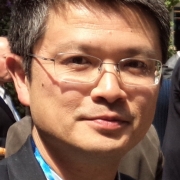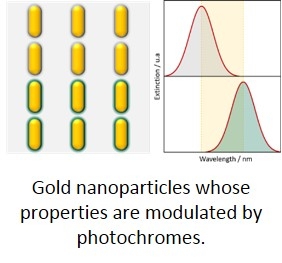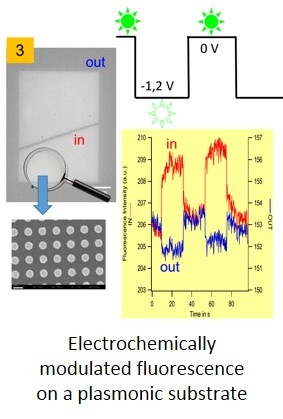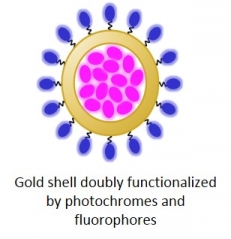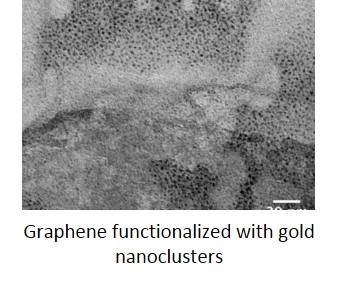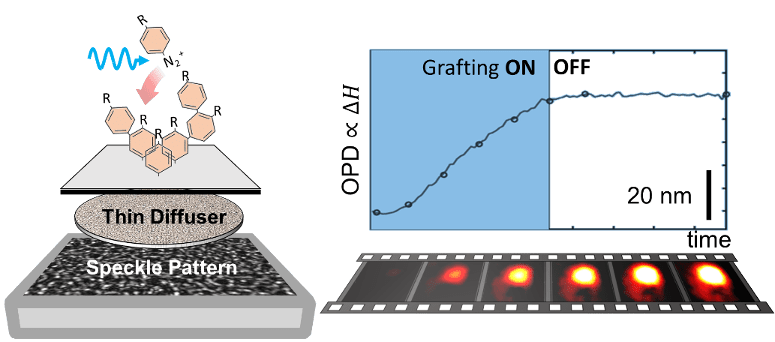Theme D: functionalized and switchable surfaces
Multiscale photo-modular plasmonic architectures
This project aims at the development of photoactive plasmonic devices presenting enhanced photophysical properties (conductance, optical and plasmonic) that can be modulated. These hybrid materials are constituted of plasmonic elementary bricks and photochromic molecules. Such multi-scale architectures are obtained by a combination of bottom-up (functionalization) and top-down methods (electronic lithography) that allows the control of the organization and orientation of the nanoparticles that are strongly coupled. The photochromic molecules are used as molecular switches to reversibly modulate the photophysical properties of the plasmonic assemblies.
Electrofluorochromic/plasmonic systems
This research axis is focused on the preparation and study of nanostructured surfaces that are optically controlled by electrochemistry. These surfaces can be used as active layer in display device, selective sensor or photoelectrode for energy conversion. Electrofluorochromic molecules are made off fluorescent compounds that can be reversibly modulated by the control of their redox state. Our work consist in organizing these molecules as monolayers or around metallic nanoparticles that are immobilized on conductive substrates. Coupling electrofluorochromic molecules with plasmonic nanostructures opens the way to multimodal commutation of the luminescence i.e. the optical signal can be controlled by electrochemical and plasmonic stimuli. We study the commutation of luminescence of these interfaces on an experimental set-up that couple fluorescence and electrochemical microscopies.
Multifunctional hollow plasmonic nanoparticles
Hollow nanoparticles are very promising because the present specific plasmonic properties that can be modulated from near UV to near infrared. Furthermore, the ability to functionalize the nanoparticles core as well as their surface opens up multiple possibilities in terms of applications. The functionalization is realized with photochromic and fluorescent molecules with the joint objective of modulating both plasmonic and fluorescent properties through the photochromic reaction. These nanoparticles will be applied to imaging and biomedical sensing.
Hybrid functional nanomaterials
This theme aims at preparing original architectures that associate a carbon based material (graphene) with nano-objects (nanoparticles, metallic clusters). This goal will be achieved by the introduction of molecular moieties that favor the incorporation of the nano-objects within the host structure in order to enhanced the final properties (plasmonic, electrocatalytic…). It is also possible to play with the nature and size of the nanoparticles to go towards other final properties while maintaining a similar synthetic approach.
In operando measurement and control of surface chemistry
This research axis aims at the development of optical methods that can monitor in real time nano-modifications on surfaces with a high lateral resolution. The focus is set on the devolvement of quantitative techniques that allows to directly access to the kinetic of the reaction that modify the surface with a sub-nanometric precision. Notably this approach allows the implementation of real time control strategies aiming at a precise quantification of the number of fixed molecules on the surface as well as their spatial distribution.
National Collaborations
• Dr M. Sliwa (LASIRE, Université de Lille)
• Dr O. Soppera (IS2M, Université de Haute-Alsace)
• Dr L. Douillard (SPEC, CEA Saclay)
• Dr N. Félidj (ITODYS, Université de Paris)
• Pr J.C Lacroix (ITODYS, Université de Paris)
• Pr A. Courty (MONARIS, Sorbonne Université)
• Dr P. Yu (ICMMO, Université Paris-Saclay)
• Dr. P. Berto (IDV, Sorbonne Université)
International Collaborations
• Pr H. Miyasaka (Osaka University, Japan)
• Pr T. Kawai (NAIST, Japan)
• Pr Nori Kobayashi (Chiba University, Japan)
Research Contracts
• ANR Active Plasmonic molecular junctions (APMJ)
Theme D managers

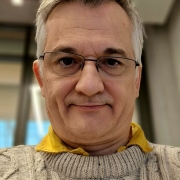
Members

